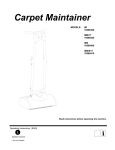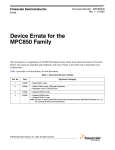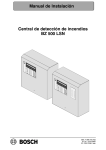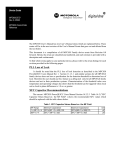Download Winegard Trav'ler Installation manual
Transcript
Winegard® Dealer Training TRAV’LER® Antennas 1 Parts 2 Installation 7 Operation 9 Conversion Kits & Troubleshooting 2 2 3 4 6 7 7 7 8 8 8 9 9 9 10 10 10 Warnings Roof Location Requirements Installing the TRAV’LER Mount Base Wiring the TRAV’LER Antenna Sealing Installing the Reflector Basic Operation Receiver Setup Search Modes Raising, Lowering, and Stowing the Antenna Hard Power Off RP-SK21/11 & OE-DISH Calibrate EL Emergency Manual Stow Accessories & Replacement Kits Accessories Replacement Kits Parts Although all TRAV’LER multi-satellite antennas include a TRAV’LER mount base and a satellite provider specific reflector, the dimensions vary in size between the DIRECTV SWM TRAV’LER antenna, the DISH®/Bell TV™ TRAV’LER antenna, and the Shaw Direct TRAV’LER antenna (see table 2.1). The following parts are included with all models of TRAV’LER antennas: • Installation/operation manual • TRAV’LER mount base with attached 30′ power/control cable • Reflector • TRAV’LER interface box • Interface box power supply • 24″ AC power cord • 30′ coaxial cable • Mounting hardware • Cable entry hardware TABLE 2.1. Dimensions of TRAV’LER antennas DIRECTV SWM TRAV’LER antenna DISH/Bell TV TRAV’LER antenna Shaw Direct TRAV’LER antenna Length of assembled antenna (see fig. 2.1A) 44″ 42″ 46″ Width of antenna with reflector (see fig. 2.1B) 34″ 25″ 37″ 23.5″ 23.5″ 23.5″ Maximum width of mount base (see fig. 2.1D) 24″ 24″ 24″ Minimum width of mount base (see fig. 2.1E) 21″ 21″ 21″ Width of antenna without reflector (see fig. 2.1C) A C B E D FIGURE 2.1. Dimensions of TRAV’LER antenna. A, Length of assembled antenna. B, Width of antenna with reflector. C, Width of antenna without reflector. D, Maximum width of mount base. E, Minimum width of mount base. Aside from the parts included with all models of TRAV’LER antennas, the DIRECTV SWM Slimline TRAV’LER (SK-SWM3) antenna also includes the following parts: 1. 21V SWM power inserter 2. DIRECTV® 4-way SWM splitter 1 TRAV’LER Multi-Satellite TV Antennas Parts Installation Warnings Do not attempt to install this system in the rain or under any wet conditions. Moisture may affect electronics and void your warranty. Do not paint the antenna. Painting the antenna will void your warranty. Pay attention to the pinch points as the antenna raises. The pinch points should be labeled on the antenna. Roof Location Requirements Before installing the antenna, make sure that the chosen location meets the minimum roof space requirements for the antenna (see table 2.2). Note that the length of the antenna must be parallel to the centerline of the vehicle. For best performance and to reduce signal acquisition time, park the vehicle on a level surface that is free of obstructions such as trees or buildings. TABLE 2.2. Roof space requirements for TRAV’LER antennas Minimum area required (length x width) DIRECTV SWM TRAV’LER antenna 44″ x 34″ DISH/Bell TV TRAV’LER antenna 42″ x 25″ Shaw Direct TRAV’LER antenna 46″ x 37″ Before removing the TRAV’LER antenna from its box, contact your RV dealer or manufacturer. Your RV may be pre-wired or have a reinforced area for this system. For the TRAV’LER antenna to safely operate, the chosen location must meet the clearance requirements for the antenna (see table 2.3). Within the operational radius (~3′), there should not be any obstructions taller than the lowest operational height of the antenna, and there should not be any obstructions above the antenna that will prevent the antenna from raising. TABLE 2.3. Clearance requirements for TRAV’LER antennas in inches Operational radius Maximum height of obstruction within operational radius Maximum height to which antenna extends above roof DIRECTV SWM TRAV’LER antenna 33″ 10″ 37.5″ DISH/Bell TV TRAV’LER antenna 32.5″ 8″ 37″ Shaw Direct TRAV’LER antenna 33″ 6″ 39″ Units pre-wired for a TRAV’LER antenna have the communication cable pre-ran for easier installation. TRAV’LER Multi-Satellite TV Antennas Installation 2 Installation Roof Location Requirements, Cont. The chosen location on the roof must be within five degrees of level and offer enough support for a secure installation. Do not install the TRAV’LER antenna in a location where a gap of 3/16″ or more exists between the bottom of the antenna and the roof, as the antenna may damage the roof. Finally, choose a location for cables to enter the vehicle. Cables must not be run through the area where the reflector stows. Cables in this area may interfere with the operation of the TRAV’LER antenna and may cause damage to the object or the antenna. Installing the TRAV’LER Mount Base Keep in mind that the more level the base is, the more quickly the antenna will locate the correct satellite. A base more than five degrees off-level may prevent the unit from acquiring signal. After choosing a location on the roof for installation, place the mount base in the chosen location. Rotate the base until the marked “FRONT” of the base faces the front of the RV. The centerline of the TRAV’LER antenna must be on or parallel to the centerline of the vehicle. Level the base front-to-back and side-to-side. Once the mount base is in the chosen location, mark through the screw holes on the base, and trace around the perimeter of the unit. Move the mount out of the installation area, and use a solid bead of sealant inside the traced outline to connect the screw marks (see fig. 2.2). FIGURE 2.2. Sealing underside of TRAV’LER base Carefully place the TRAV’LER mount base directly onto the sealant. Check with your vehicle manufacturer for any special screw requirements for your vehicle, and screw the mount base to the roof with nine screws. 3 TRAV’LER Multi-Satellite TV Antennas Installation Installation Wiring the TRAV’LER Antenna Once the base has been properly installed, cables should be connected. Cables should be run with some slack. In order to leave room for service, do not pull cables too tightly. Depending on the length of the cable on the roof, you may need to use cable clamps between the unit and the cable entry plate. Clamping every 12–16″ should eliminate any unnecessary cable movement. The DISH/Bell TV TRAV’LER antenna and Shaw Direct TRAV’LER antenna all require the following steps for connecting to the interface box: 1. Connect the power/control cable running from the mount base to the “DC OUT/ANT. COMM.” port of the interface box. 2. Connect the power supply to the “DC IN” port of the interface box. 3. Connect one end of the AC power cord to the power supply and the other end to a 110V outlet. When routing coax cable, avoid sharp turns in coax cable to prevent cable damage. Do not cut the 30’ power/control cable. If shortening the length of the supplied coax cables, be careful not to cut the black power/control cable. If setting up a DISH/Bell TV or Shaw Direct TRAV’LER antenna, then connect a coax cable from the mount base to each receiver (see fig. 2.3). The power supply must be used for all installations. The TRAV’LER antenna requires 48 VDC from the power supply. Power Supply The DISH/Bell TV TRAV’LER antenna is compatible with DISH Pro Plus separators and triplexers. A DISH Pro Plus separator or triplexer can adapt a single coax cable for use with dual input receivers, however, they may not be used with domes. Interface Box Receiver Receiver Receiver FIGURE 2.3. Cable connections for DISH/Bell TV or Shaw Direct TRAV’LER antenna (SK-1000 pictured here) If using three receivers, connect the third receiver to port C. Coax port C is disabled during the search process; as a result, signal acquisition may be delayed for the third receiver. TRAV’LER Multi-Satellite TV Antennas Installation 4 Installation Wiring the TRAV’LER Antenna, Cont. When connecting the DIRECTV SWM TRAV’LER antenna to receiver(s), only port C should be used for making connections to the mount base; multiple receivers will connect to the mount base via the provided splitter. The power inserter must not be mounted on the roof of the vehicle. The power inserter must always be installed inside the vehicle. If hooking up to only one receiver, the splitter is not needed, but the power inserter must still be installed. To connect the DIRECTV SWM TRAV’LER antenna to receiver(s), complete the following steps (see fig 2.4): 1. Connect the power/control cable running from the mount base to the “DC OUT/ANT. COMM.” port of the interface box. 2. Connect the power supply to the “DC IN” port of the interface box. 3. Connect one end of the AC power cord to the power supply and the other end to a 110 V outlet. 4. Connect a coax cable running from port “C” of the mount base to the “POWER TO SWM” port of the power inserter. 5. Connect a coax cable from the “SIGNAL TO IRD” port of the power inserter to the “In from SWM” port of the splitter. Terminate unused splitter outputs with a 75 ohm termination cap. 6. Connect a coax cable from the splitter to each receiver. The receiver(s) should already be connected to the TV(s). 7. Plug in the power inserter to a 110 V outlet. Power Supply Interface Box The DIRECTV SWM TRAV’LER antenna can alternatively be wired so that a cable runs from the TRAV’LER antenna to the splitter and from the splitter to the power inserter and receiver(s). In this setup option, the splitter can be mounted on the roof of the vehicle. For more information, refer to the installation manual. Power Inserter Splitter Non-DVR Receiver DVR Receiver FIGURE 2.4. Wiring option for DIRECTV SWM TRAV’LER antenna 5 TRAV’LER Multi-Satellite TV Antennas Installation Installation Sealing After completing wiring, return to the roof. Seal around the hole where cables enter the vehicle, and seal around the cable entry plate (see fig. 2.5). A B C D FIGURE 2.5. Sealing point of cable entry. A, Positioning cable entry plate over sealed hole. B, Securing cable entry plate to roof. C, Securing cable clamps. D, Sealing. The unit can be removed from the transition plate. See figure 2.7. Run a solid bead of sealant around the edge where the transition plate meets the roof, making sure to cover each screw head (see fig. 2.6). Be careful not to get any sealant above the transition plate. This way, the unit can be removed (if necessary) from the transition plate without breaking the sealant. FIGURE 2.7. Unit (right) removed from transition plate (left) Do not seal above here If the TRAV’LER antenna is not sealed properly, water may get into the unit, and the unit will fail due to corrosion. FIGURE 2.6. Sealant correctly applied and preventing water intrusion TRAV’LER Multi-Satellite TV Antennas Installation 6 Operation Installing the Reflector If it is not possible to install the reflector with the unit in the stowed position, press “POWER” to turn on the unit, and as the antenna raises, press “POWER” and “SELECT” at the same time; when the antenna stops moving, the reflector can then be installed. In most cases, the reflector can be installed with the unit in the stowed position. Basic Operation Once the sealant has begun to cure, the TRAV’LER antenna can be raised by pressing and holding “POWER” for two seconds; the antenna will then automatically begin searching for satellites. The top line of the interface screen will display the antenna type, and after peaking on a signal, the bottom line of the interface screen will display an asterisk for each satellite found (see table 2.4). Before traveling, the antenna must be stowed. Press “POWER” to stow the antenna. Once the antenna is stowed, the power will shut off. TABLE 2.4. Interface box displays for various TRAV’LER antennas If the TRAV’LER antenna cannot find the primary satellite (119° for DISH, 101° for DIRECTV, 91.5° for Bell TV, or 107° for Shaw Direct) due to an obstruction, the search routine will fail. In this case, the TRAV’LER antenna will stow, and the interface box will indicate a failed search. Antenna type (top line display) Possible satellites found (bottom line display) DIRECTV SWM TRAV’LER antenna LG DTV SWM3 *101 *99 *103 DISH/Bell TV TRAV’LER antenna (used with DISH programming) SM Dish 1000 *119 *110 *129 DISH/Bell TV TRAV’LER antenna (used with Bell TV programming) SM ExpressVu *91 *82 Shaw Direct TRAV’LER antenna LG Shaw Direct *111 *107 Receiver Setup After the TRAV’LER antenna has found and locked onto satellites, the receiver needs to be set with the following selections (see fig. 2.8). Online receiver setup guides are available for the TRAV’LER antenna at www.winegard.com/receivers/ setupguide.php. FIGURE 2.8. Receiver setup selections. A, DISH selections. B, DIRECTV selections. 7 TRAV’LER Multi-Satellite TV Antennas Operation Operation Search Modes The TRAV’LER antenna offers a simple one-button automatic operation. In addition to Automatic mode, the interface includes a Manual mode with a user menu for advanced features. Always use Automatic mode for normal operation. The Diagnostics menu should not be entered or used unless advised by Winegard personnel. Raising, Lowering, and Stowing the Antenna The user menu includes options to manually move the dish, including raising, lowering, and stowing the antenna. To enter the user menu, press the Power button for two seconds or until the interface displays “POWER ON.” Once the power is on, release the Power button, and press and hold the Enter button for two seconds. The interface will ask if you wish to enter the user menu. Press the Select button to move the asterisk to “Yes,” and press the Enter button to confirm the selection. To raise, lower, or stow the antenna, enter the Installation menu by pressing the Select button until the asterisk is next to Installation and then pressing the Enter button to confirm the selection. From the Installation menu, the antenna can be manually raised or stowed. The antenna will raise in increments. The antenna can also be lowered from the Installation menu. Keep in mind, however, that lowering the antenna is not the same as stowing the antenna, even though the antenna may appear to be stowed. The lower function was designed to help a user who may hit an obstruction while deploying and who needs a way to lower the unit in order to prevent damage. When lowering the dish, it is a good idea to have someone watch the operation of the TRAV’LER antenna; if the TRAV’LER antenna is skewed, the reflector may contact and/or damage the roof. When entering the user menu, the antenna will automatically begin the search routine if the Enter button is not pressed within ten seconds of powering on the unit. The TRAV’LER interface box can be operated via three buttons: the Power button, Select button, and Enter button. The Power button turns on/off the antenna. The Select button moves between selections. The Enter button confirms a selection. See figure 2.9. WINEGARD COMPANY POWER ON A B C FIGURE 2.9. Interface box. A, Power button. B, Select button. C, Enter button. Warning: when lowering the antenna, the antenna lowers in its current position and may potentially lower onto anything that is underneath the dish. Hard Power Off To activate the hard power off features, press and hold the Power button and Select button at the same time. The TRAV’LER antenna will stop and turn off. If the hard power off feature is used, the TRAV’LER antenna may not be in a safe position for travel. Do not move the vehicle until the unit is in the stowed position. TRAV’LER Multi-Satellite TV Antennas Operation 8 Conversion Kits & Troubleshooting During a conversion to a DISH TRAV’LER antenna, the reflector and cable harness have been removed. The coaxial cables are disconnected from the turret. The reflector bracket and stiffener plate have not yet been removed (see fig. 2.10). A B FIGURE 2.10. Reflector, cable harness, and coaxial cables removed and/or disconnected for conversion. A, Reflector bracket. B, Stiffener plate. To install the DISH reflector and LNB assembly, four holes in the reflector bracket must align with four holes in the adaptor plate (see fig. 2.11). 1 1 2 4 3 2 4 3 FIGURE 2.11. Four holes to align in reflector bracket (left) and adaptor plate (right) 9 RP-SK21/11 & OE-DISH Conversion kits are available for the TRAV’LER antenna. The conversion kits are compatible with converting the DIRECTV Slimline antenna (SK-3005), DIRECTV triple LNB (SK-3003), or DIRECTV SWM Slimline antenna (SK-SWM3) to the DISH TRAV’LER antenna (SK-1000). To convert from a DIRECTV TRAV’LER antenna to a DISH TRAV’LER antenna, complete the following steps: 1. If converting a DIRECTV SWM Slimline antenna to a DISH TRAV’LER antenna, remove the power inserter and SWM splitter; these will not be used. 2. Remove the reflector. 3. Disconnect the coaxial cables from the turret, remove the bolt holding the cable harness to the unit, and detach the cable harness from the lift arm. 4. Remove the reflector bracket. If applicable, remove the stiffener plate. 5. If applicable, remove the adaptor plate. 6. If applicable, install a new adaptor plate. Then, align the four holes on the inside of the reflector bracket with the four holes in the adaptor plate (see fig. 2.11). Replace 3/16″ Allen screws through the four holes, and tighten. 7. Connect and tighten the coax cables. Leave port D open, and install an F-cap on port D. The F-cap will not be used if converting from a SWM TRAV’LER antenna. 8. Replace the clamp that holds the coax cables to the arm with a 5/16″ screw. If the cable tie is missing or was not used to mark the position of the clamp on the cable harness, install the clamp 14″ from the end of the connectors. 9. Set the IDU for DISH 1000. 10. Repackage the LNB, and return the repackaged parts to Winegard. Calibrate EL If the TRAV’LER antenna is stuck in the deployed position, the elevation may need to be re-calibrated. Select “Calibrate EL” from the Installation menu. After a few moments, the interface box will display, “On EL hard stop?/Yes No*.” If the antenna is pointing as far upwards as it can go, then press the Select button to move the asterisk to “Yes,” and press Enter to confirm the selection. The antenna should now be able to be stowed. If not, contact Winegard Technical Services for additional help, or follow the emergency manual stow procedure. “Restore to factory defaults” is also used when issues occur. Emergency Manual Stow Emergency manual stow can be used as a last resort if unable to stow the antenna otherwise. First, unplug the interface box. Then, remove the black plastic bolt from the back of the mount. Insert a 3/8″ socket extension into the auxiliary drive, and turn clockwise to lower the unit. Do not use a drill! TRAV’LER Multi-Satellite TV Antennas Conversion Kits & Troubleshooting Accessories & Replacement Kits Accessories Various accessories are available for the TRAV’LER antenna, including Model CL-SK26 control cable extension, Model SKA-004 roller plate, and Model SKA-008 thin roof plate. Model CL-SK26 is a 25′ power/ communication cable that connects directly to the existing TRAV’LER power cable to allow runs up to 55′. Model SKA-004 is a roller plate for protecting a rubber RV roof. Model SKA-008 is a thin roof support plate for reinforcement at the TRAV’LER antenna mounting location. Accessories available include Model SKA-004 roller plate and Model SKA-008 thin roof support plate (see fig. 2.12). Replacement Kits The following replacement kits are available for the TRAV’LER antenna: a. Turret Replacement Kits • SK-LG00, Large Motor Turret for DIRECTV Slimline/SWM3 • SK-SM00, Small Motor Turret for DISH 1000/DIRECTV triple LNB • RP-SK20,Transition Plate Replacement b. LNB Replacement Kits • RP-SK01, DISH1000 - 2780490 • RP-SK05, DIRECTV Slimline 5 - 2780594 • RP-SK09, DIRECTV SWM3 - 2780156 • RP-SK73, Shaw Direct c. Reflector Replacements • RP-SK11, DISH 1000 • RP-SK33, DIRECTV Triple • RP-SK35, DIRECTV Slimline 5/ SWM3 d. Sheathed Cables from LNB to Turret with P-Clamp and screw • RP-SK41, DISH 1000 – 3753873 • RP-SK45, DIRECTV SL5 – 3753881 • RP-SK47, Shaw – 3753895 • RP-SK49, DIRECTV SWM3 – 3753110 e. Back-up and Feed Arm Assembly with No LNB or Sheathed Coax • RP-SK81, DISH 1000 • RP-SK89, DIRECTV Slimline 5 & SWM3 f. Back-up and Feed Arm Assembly with LNB and Coax • RP-SK95, DIRECTV SWM3 • RP-SK65, DIRECTV Slimline 5 • RP-SK63, DIRECTV Triple • RP-SK21, DISH 1000 g. Interior Components • RP-SK87, Power Supply and 24″ Power Cord • RP-SK83, IDU • SKM-854, IDU, Power Supply, and 24″ Power Cord A B FIGURE 2.12. Available accessories. A, Model SKA-004. B, Model SKA-008. TRAV’LER Multi-Satellite TV Antennas Accessories & Replacement Kits 10 Winegard Company • 3000 Kirkwood Street • Burlington, IA 52601 • 1-800-288-8094 • Fax 319-754-0787 • www.winegard.com Printed in U.S.A. ©2013 Winegard Company 2/15 Winegard, RoadTrip, Mission, TRAV’LER, Carryout, Pathway and Rayzar are registered trademarks of Winegard Company. DIRECTV is a registered trademark of DIRECTV, LLC. DISH is a registered trademark of DISH Network L.L.C. Bell TV is a trademark of Bell Canada, Inc. Shaw Direct is a trademark of Shaw Satellite G.P. Disclaimer: Although every effort has been made to ensure that the information in this document is correct and complete, no company shall be held liable for any errors or omissions in this document. Information provided was accurate at time of printing.





















